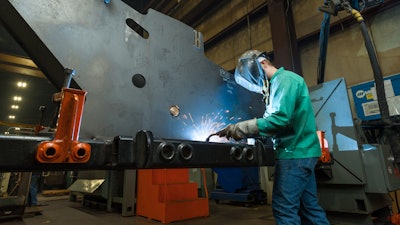
Demand for heavy equipment is strong in transportation, construction, industrial and other industries. Yet, labor constraints make it difficult for original equipment manufacturers (OEMs) to take full advantage of market opportunities. OEMs typically have complex supply chains and numerous suppliers, all of whom are struggling to meet customer delivery schedules, due in large part to the ongoing worker shortage.
And, while suppliers can’t control the quality and size of the labor pool, they can more effectively utilize the workforce they already have in place by amping up their use of material handling automation. Supplier-partner investments in material handling automation can help OEM customers meet forecasts in spite of labor gaps.
Besides positively affecting safety, quality, productivity and costs – all benefits to OEM customers – automation creates efficiencies that diminish worker shortage impacts. Specifically, material handling automation can:
- Improve production capacity and on-time delivery predictability.
- Add greater predictability to workflows, giving suppliers the ability to more accurately plan what they can produce. That improves on-time delivery by removing many of the unknowns that can negatively impact capacity.
- Reduce the effects of a tight and volatile labor market.
Material handling tasks generally are well-suited for automation because they don’t necessarily require complex skills. When suppliers automate some of these indirect labor activities, they can redeploy workers into roles that humans can best perform. Filling skilled positions responsible for direct labor tasks with existing personnel and leaving some less-skilled work to machines relieves workforce shortage pressures.
Material handling automation helps suppliers operate and manage labor more efficiently, so they can produce higher-quality parts at lower costs. Those savings are unlocked through the reduction of indirect labor needs, or lower overhead, and fewer ineffective parts. Less rework also results in less scrap, further decreasing costs.
Contributing to a Safer Work Environment
Automation effectively reduces material-handling accidents in a supplier’s facility. Keeping people safer at work is a priority for the good of workers themselves, and it contributes to lower overall operating costs. Fewer safety incidents also mean more people on the job they were hired to do, which positively affects supplier performance and productivity.
While machines aren’t perfect, they are consistent. Implementing greater material handling automation allows suppliers to more predictably anticipate defects and, as a result, better plan for, understand and correct them. Human errors are more frequent and may create issues that are more difficult to control. A supplier’s quality and engineering professionals can more easily address machine-made defects than they can man-made ones.
Supplier investments in material handling automation in and of itself won’t help OEMs overcome market challenges. Rather, supplier partners considering automation must strategically consider and select specific installations based on which will best serve OEM customers.
Strategic automation decisions should be heavily weighted toward OEM needs, while also ensuring that investments increase productivity and effectively reduce recordable safety incidents, human-caused defects and indirect labor costs. These automation best practices will positively impact cost, quality and delivery for customers.
To ensure their supplier partners are implementing material handling automation and other measures specifically designed to help them respond to end-customer demand, OEMs should ask:
- How are you going to reduce costs, while improving quality and delivery performance, over time?
- How are you addressing the labor shortage? Part of the answer should include automation, as the tight labor market is expected to continue into the foreseeable future.
Supplier partners should be focusing automation solutions on areas where they make the greatest impact on OEM customers’ most important deliverables. Done thoughtfully and strategically, material handling automation will increase capacity, productivity and predictability, unclogging the supply chain and easing labor constraints.
---
Paul Sorek is the director of business operations at Miller Fabrication Solutions.






















